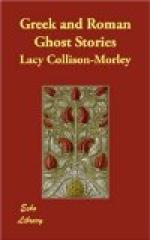The god-fearing AElian seeks to show that Providence watches over a good man and brings his murderers to justice by a story taken from Chrysippus.[91] A traveller put up at an inn in Megara, wearing a belt full of gold. The innkeeper discovered that he had the money about him, and murdered him at night, having arranged to carry his body outside the gates in a dung-cart. But meanwhile the murdered man appeared to a citizen of the town and told him what had happened. The man was impressed by the vision. Investigations were made, and the murderer was caught exactly where the ghost had indicated, and was duly punished.
This is one of the very few stories in which the apparition is seen at or near the moment of death, as is the case in the vast majority of the well-authenticated cases collected during recent years.
Aristeas of Proconesus, a man of high birth, died quite suddenly in a fulling establishment in his native town.[92] The owner locked the building and went to inform his relatives, when a man from Cyzicus, hearing the news, denied it, saying that Aristeas had met him on the way thither and talked to him; and when the relatives came, prepared to remove the body, they found no Aristeas, either alive or dead. Altogether, he seems to have been a remarkable person. He disappeared for seven years, and then appeared in Proconesus and wrote an epic poem called Arimispea, which was well known in Herodotus’s day. Two hundred and forty years later he was seen again, this time at Metapontum, and bade the citizens build a shrine to Apollo, and near it erect a statue to himself, as Apollo would come to them alone of the Italian Greeks, and he would be seen following in the form of a raven. The townsmen were troubled at the apparition, and consulted the Delphic oracle, which confirmed all that Aristeas had said; and Apollo received his temple and Aristeas his statue in the market-place.
Apollonius[93] tells virtually the same story, except that in his version Aristeas was seen giving a lesson in literature by a number of persons in Sicily at the very hour he died in Proconesus. He says that Aristeas appeared at intervals for a number of years after his death. The elder Pliny[94] also speaks of Aristeas, saying that at Proconesus his soul was seen to leave his body in the form of a raven, though he regards the tale as in all probability a fabrication.
The doctor in Lucian’s Philopseudus (c. 26) declares that he knew a man who rose from the dead twenty days after he was buried, and that he attended him after his resurrection. But when asked how it was the body did not decompose or the man die of hunger, he has no answer to give.
Dio Cassius[95] describes how, when Nero wished to cut a canal through the Isthmus of Corinth, blood spurted up in front of those who first touched the earth, groans and cries were heard, and a number of ghosts appeared. Not till Nero took a pickaxe and began to work himself, to encourage the men, was any real progress made.




